A self-study, self-paced course where you can learn how to paint in watercolor by watching video lessons and doing assignments
$297 USD
ENROLL NOWA self-study, self-paced course where you can learn how to paint in watercolor by watching video lessons and doing assignments
$297 USD
ENROLL NOWOne-to-one, unlimited and custom-tailored to your skills and needs Personal Tutoring by the Watercolor Academy teachers
$997 USD
ENROLL NOWBy Ilya Ibryaev
In this video lesson, I will show you how to paint a seascape in watercolor.
This artwork is painted outdoors, on location on a wonderful Mediterranean beach. Here is the impressionist artwork that I managed to make in one painting session.
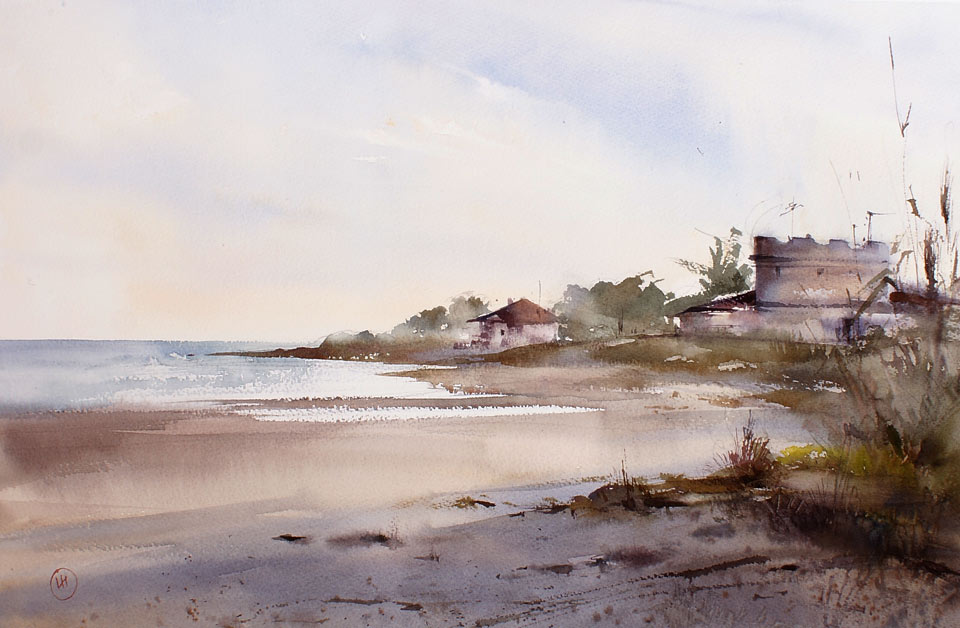
It is late afternoon. The sky is clear and soft light fills the beach and all its surroundings with warm colors. To decide on the composition of this artwork, I am making a very laconic sketch in graphite pencil.
I start by painting the warm sunlight of the sky, using the yellow ochre light and Cadmium orange paint colors. The paint is applied with a round mop brush – as this holds a lot of water, this allows me to make big washes without reloading the brush too often. The tone of this wash is very light, you may also notice that I am leaving some white paper spots unpainted. This is done on purpose; I would like to create an illusion of white clouds on the sky. Although the sky in real-life has no clouds, I am using an artistic license to paint what I like, rather than repeat what I see. Nevertheless, the clouds that I have in mind will be very soft and the impression will be very similar to the sky we have today.
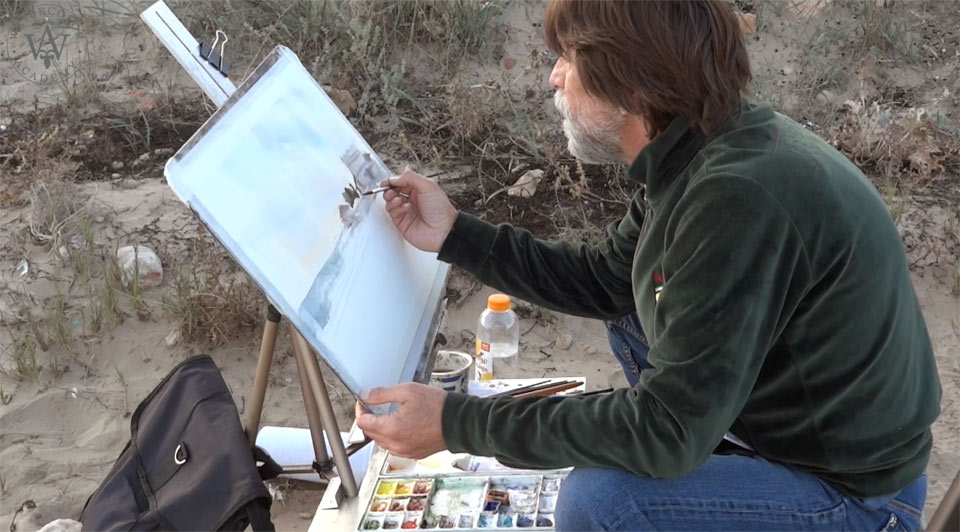
I add a bit more Cadmium orange closer to the horizon, painting this tint wet-into-wet. You may be wondering why I am painting the blue sky with yellow ochre and Cadmium orange. Don't worry, the sky will appear blue when I am finished, but it won't be cold blue – it will be filled with warmer sunlight. It is now time to add a blue pigment into this wah. For the blue sky color, I use Ultramarine. I apply the blue light tint with wide brushstrokes, leaving gaps between them. Because I am using the wet-into-wet painting method, the warm and cold colors intermix directly on paper. To help pigments intermix even better, I rotate the board upside down, and at various angles, for the gravity to do its work, allowing the paint to flow downwards in different directions. I can also fix this flow with a few brushstrokes, which absorbs excess water. It is very important to keep wetness under control and not to overload the paper with water. For the darker clouds at the top, I apply a mix of Ultramarine with Cadmium orange. You may see that I am holding the board turned to its side – this helps to ensure that violet clouds do not run downward to the horizon.
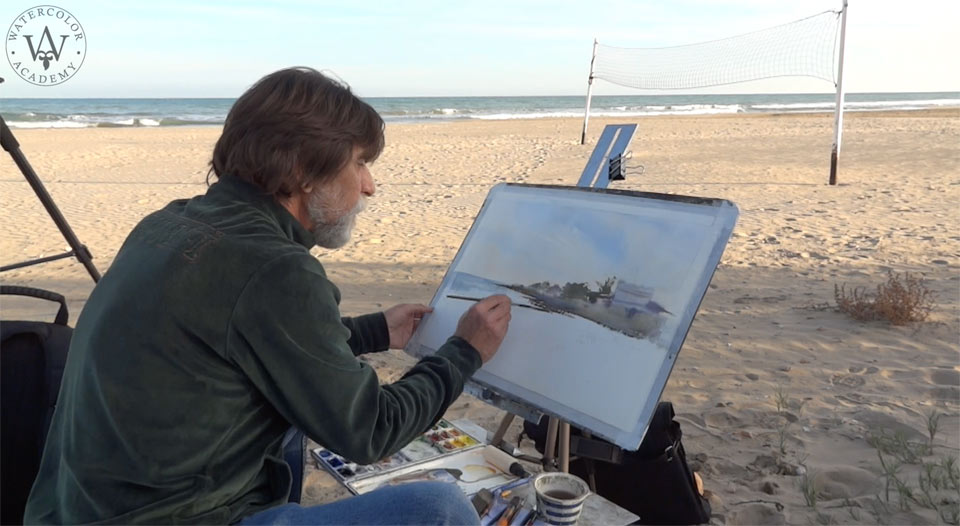
I load the top part of the sky with more pigment, to make it darker. This creates the illusion of a more realistic sky, which is dark close to the zenith and lighter toward the horizon. Excess water should be wiped off with a damp clean brush; this will help to avoid paint runs when I place the board back on the easel. I am quite happy with the sky so far, as it is blue and light. Moving on, I will start painting the sea. For its color, I use a mix of Ultramarine with Cadmium orange and the blue-green pigment, Veridian. I apply this mix with swift brushstrokes. You may see that I intentionally leave white spots unpainted. This happens because there is very little water on the brush, as well as my fast brushstrokes. This painting method is referred to as 'dry brush'.
I fix the horizon line with a small brush. A wide flat brush is used to paint a building on the middle-ground. I am facing the Sun, which is slowly setting, hence why the wall of the building in front of me is in shadow. For its dark cold color, I use the Ultramarine and Cadmium orange mix. These two complementary pigments produce a silvery-gray color, which can vary from cold to warm shades, depending on the amount of each pigment in the mix. The same pigments (Ultramarine and Cadmium orange) are used for the smaller building in the background; however, this time the mix is a bit more grayish. These two pigments can give a very wide range of color temperatures, and tonal values.
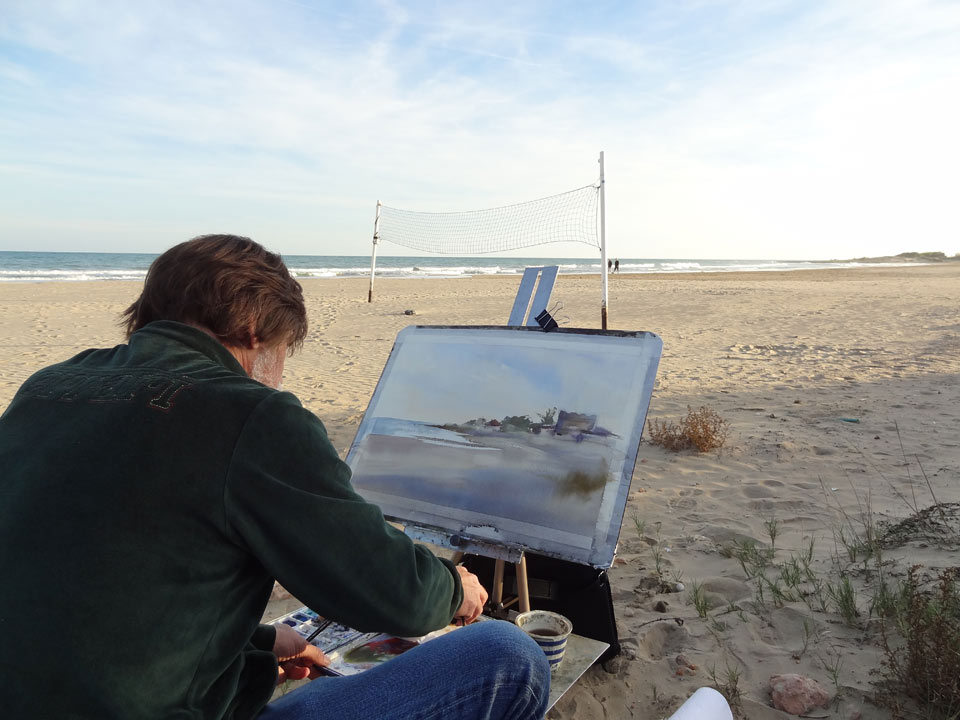
The front-line buildings have many details; however, I don't have to paint every single detail I see in front of me. I am aiming to make a creative impression of this place, not a photorealistic document about it. I therefore omit many details in this artwork, and instead concentrate on colors and tones. You may also see that I paint some details wet-on-dry, and others wet-into-wet. This helps to create a rich texture, because the variety of different painting methods always looks better when utilized in the same watercolor artwork. I am painting the greenery with a small round brush, using free and loose brushstrokes. Three main pigments are used for this greenery: Ultramarine, Cadmium orange and Sap green. It is always better to mix different colors in order to make green, rather than use the green paint straight from the tube. To paint the ground, I use a mix of Cadmium orange, Cadmium red and green pigments. I load the brush with very little water, but enough pigment to make dark tone brushes. For the color of the ground, I mix Cadmium orange, Cadmium red and Ultramarine. A bigger, round brush is more suitable to produce wide free-flowing brushstrokes.
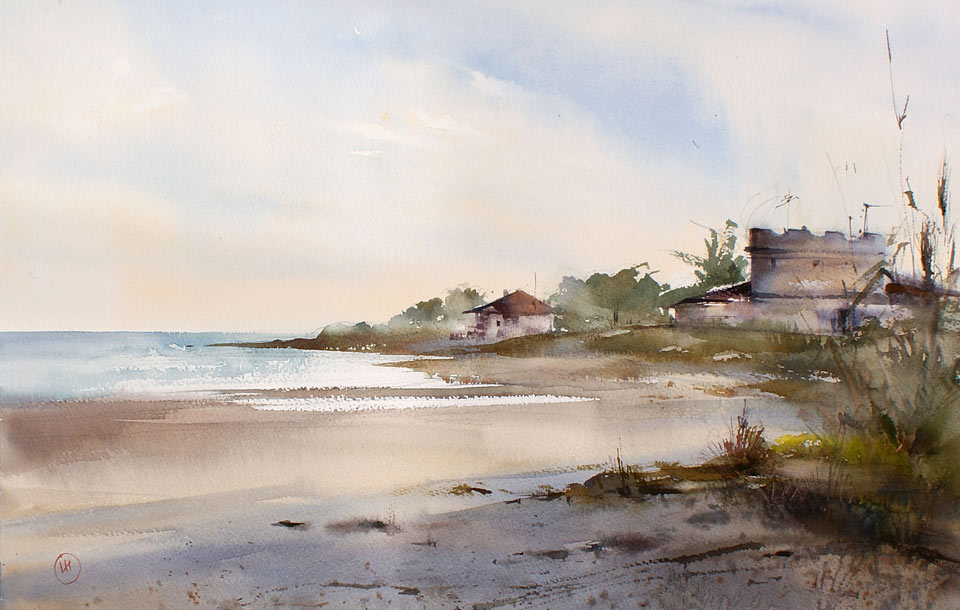
With a smaller brush, I add more pigment wet-into-wet. I continue the wash using a mop brush, applying Cadmium orange, Ultramarine and ochre pigments mixed together on the palette. As the Sun moves closer to the horizon, the shadows are slowly becoming longer. To paint the shadows on the beach, I use Ultramarine and Cadmium orange. There are green bushes next to the beach, and for their color, I mix Cadmium orange, Sap green, and Cadmium red. The long shadow casted by this bush is cold. I paint it using a mix of Ultramarine and Cadmium orange.
All main washes on this artwork are in place, so I wait for the paper to dry a bit. I can now work on smaller details, meaning that this artwork will be completed soon. A dark mix of Cadmium orange and Sap green is warm in color, and I paint with it grasses and bushes next to the beach. A little bit of Ultramarine is added to this mix, making it darker and colder. This color creates an illusion of shadows. Because I am aiming to make this artwork impressionistic, all greenery is painted in very loose brushstrokes. The shaded areas of the beach are painted over using the Ultramarine and Cadmium orange mix. Since Ultramarine and Cadmium red give a deeper and warmer shade; I use this shade to add some accents to greenery and the beach...
A self-study, self-paced course where you can learn how to paint in watercolor by watching video lessons and doing assignments
One-time payment - Lifetime membership
$297 USD
One-to-one, unlimited and custom-tailored to your skills and needs Personal Tutoring by the Watercolor Academy teachers
One-time payment - Lifetime membership
$997 USD